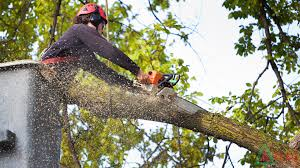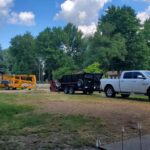Tree removal permits in Cedar Park depend on size, location, and what kind of tree you have. You need a permit for protected trees over 19 inches wide or any heritage tree. Trees near creeks or in flood zones also require approval. However, most smaller trees on your property don’t need permits.
Keep reading to find out when you need approval and how to stay out of trouble with the city.
When Is A Permit Needed for Cedar Park Tree Removal Service?
Cedar Park wants permits for certain tree situations. Bigger trees and native species need city approval first. Knowing these rules saves you from fines and headaches later.
Protected Tree Species Requirements
Some native trees get special treatment under local rules. Live oaks and pecans usually need permits before you can cut them down.
What Makes a Tree Protected in Cedar Park?
The city looks at how wide the tree is, what type it is, and where it sits on your property. They measure the trunk about chest high, around 4.5 feet up from the ground. Here’s what counts as protected:
- Live oaks that measure 19 inches across or bigger
- Pecan trees over 19 inches wide
- Any tree sitting in a flood zone
- Trees close to creeks or streams
Trees in Environmentally Sensitive Areas
Creek areas and flood zones have tighter rules than regular yards. These spots help stop erosion and keep the water clean. Taking down trees here means extra paperwork and city reviews.
How Far Do Creek Buffers Extend?
Most creek buffers go out 25 to 100 feet from the middle of the water. The exact distance changes based on the creek size and what’s built nearby. Your property survey shows where these lines are, or you can ask city planning folks to check.
Large Diameter Tree Removal
Size matters even if the tree isn’t a protected type. Anything over 19 inches wide needs approval before cutting. This keeps the neighborhood looking good and helps property values.
Does Diameter Include All Tree Trunks?
Yes. Trees with multiple trunks get measured differently than single ones. You add up all the trunk widths to get your total. Three trunks at 8 inches each gives you 24 inches total, which means you need that permit.
Construction and Development Projects
Building something new or doing big changes means getting a tree survey done. You have to show which trees stay and how you’ll keep roots safe while building. City staff will review everything before saying yes. A local tree service in Cedar Park can help you understand these rules better.
Trees Near Property Lines
Shared trees or ones in easement areas need your neighbor’s okay plus permits. Power company easements add more rules since they need access to their lines. Look at your property papers to find these spots.
When Is A Permit Not Needed?
Plenty of normal situations where they will let you do tree service without asking the city first. These rules help you deal with problems and take care of your yard.
- Dead or Dying Trees: Trees that pose real dangers can come down without permits. Snap some photos of the damage just in case someone asks questions down the road.
- Small Diameter Trees: Anything under 19 inches wide doesn’t hit the permit level. Most younger trees and decorative ones you plant for looks fall into this category.
- Emergency Storm Damage: Trees that fall during storms need quick removal for safety. You can clear the mess right away and let the city know about it soon after.
- Trees Outside City Limits: County land follows different rules than city property does. Williamson County usually has fewer restrictions on what you can remove from private land.
- Non-Protected Species: Regular landscape trees like crape myrtles don’t need permits at all. These planted trees don’t have the same value to local wildlife that native ones do.
<iframe src=”https://www.google.com/maps/embed?pb=!1m14!1m8!1m3!1d951713.2779077447!2d-97.807296!3d30.555293000000002!3m2!1i1024!2i768!4f13.1!3m3!1m2!1s0xae694a1a8cbeb49f%3A0xe6dbb1d844b6432c!2sRooted%20In%20Texas%20Tree%20Care!5e1!3m2!1sen!2sus!4v1761057761891!5m2!1sen!2sus” width=”400″ height=”300″ style=”border:0;” allowfullscreen=”” loading=”lazy” referrerpolicy=”no-referrer-when-downgrade”></iframe>






